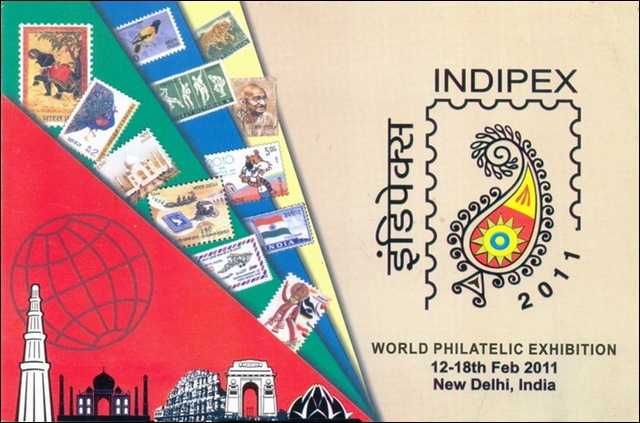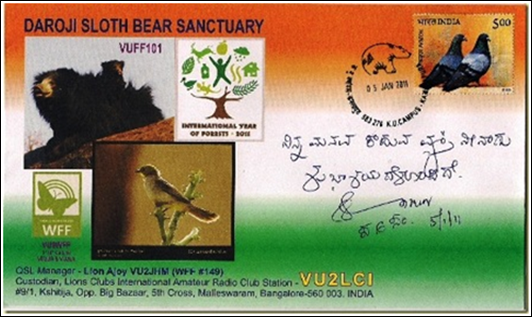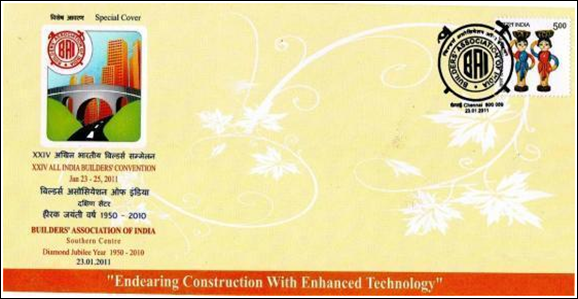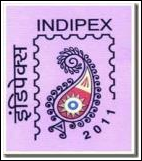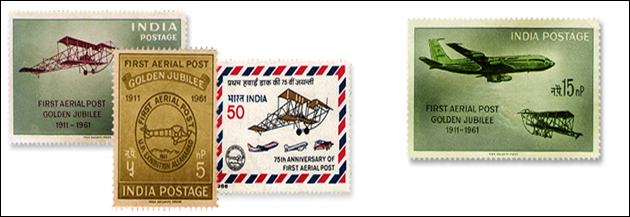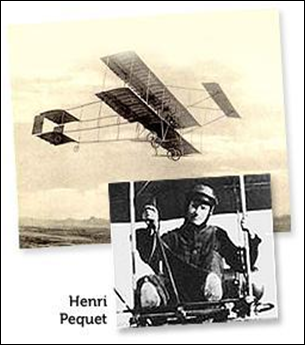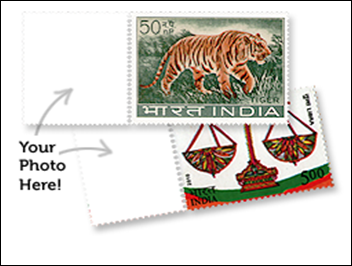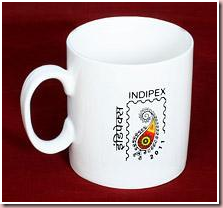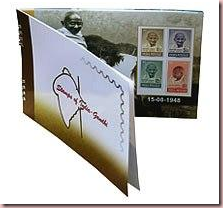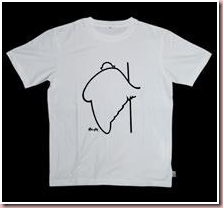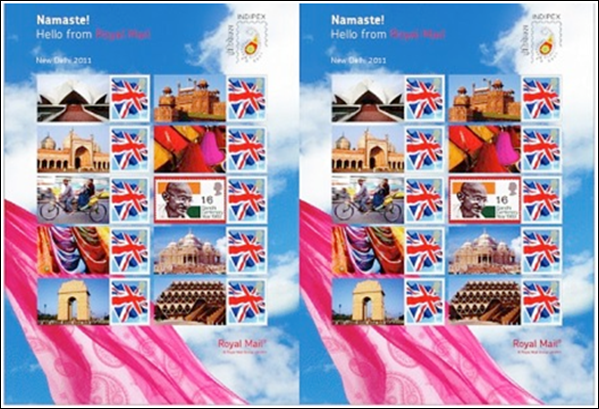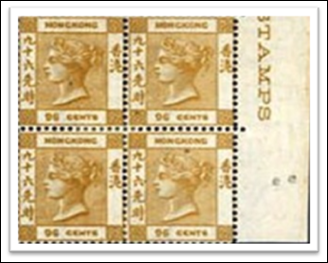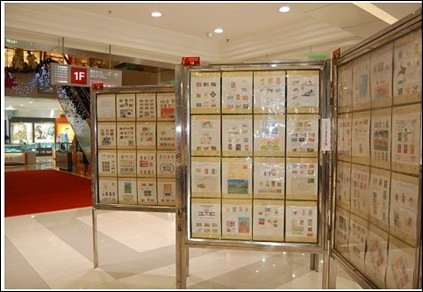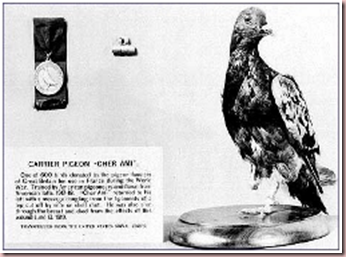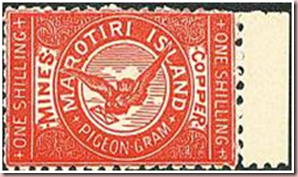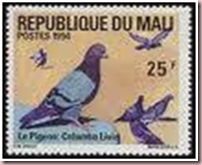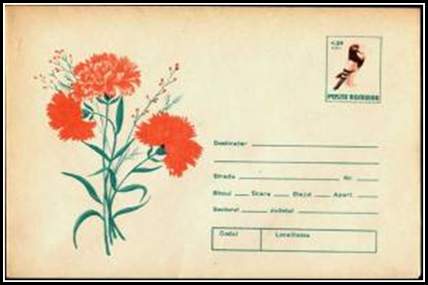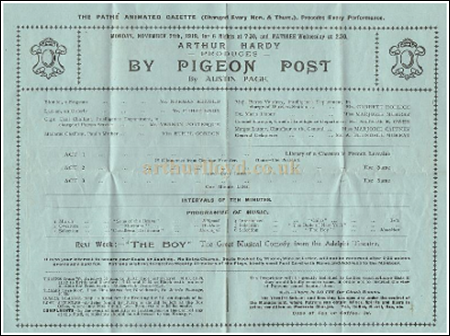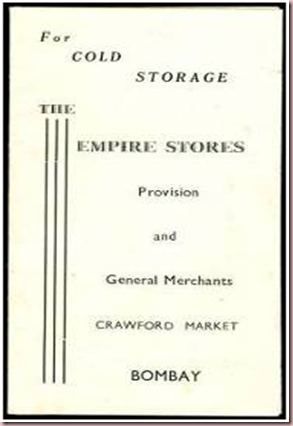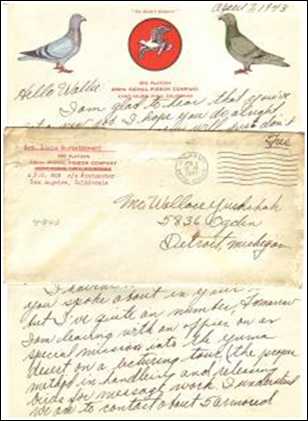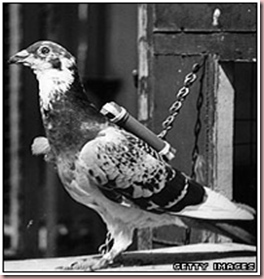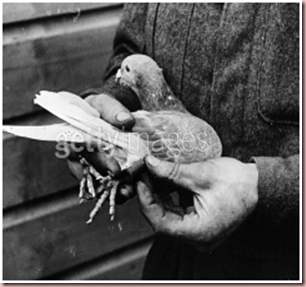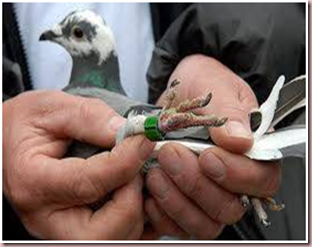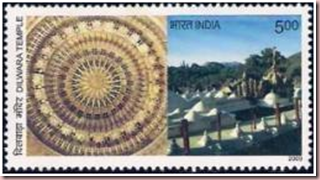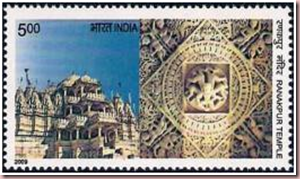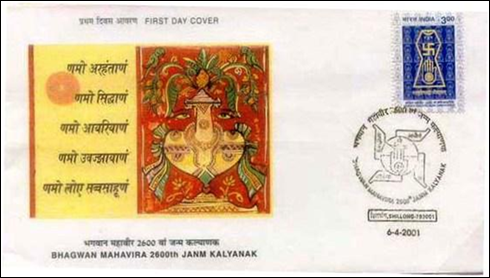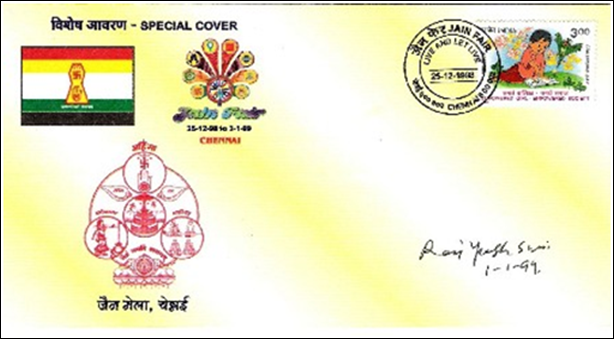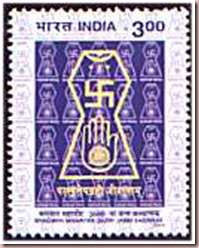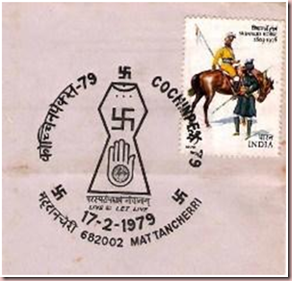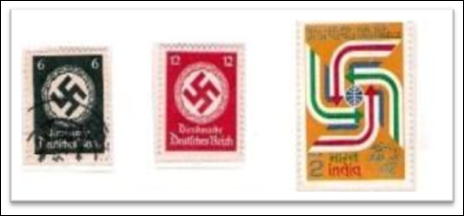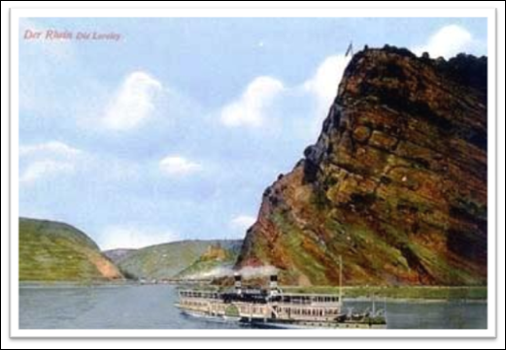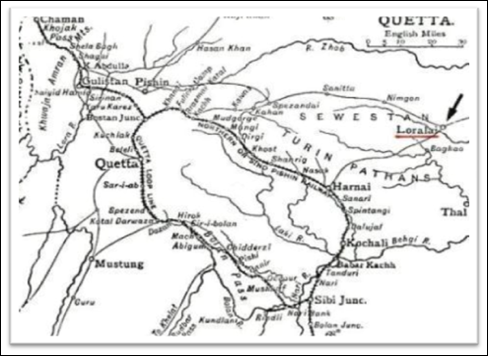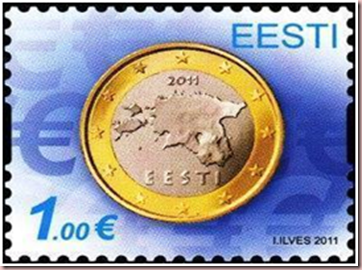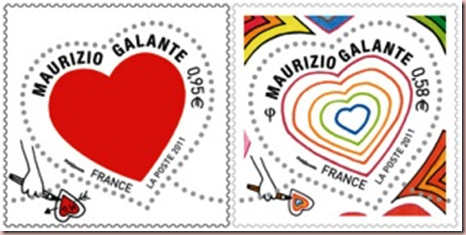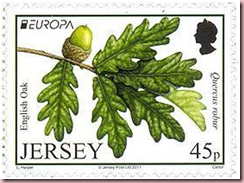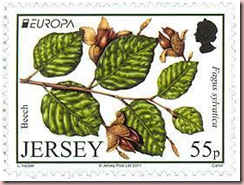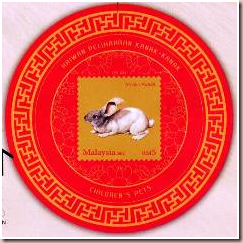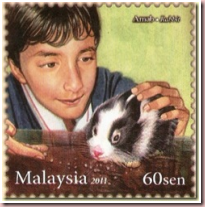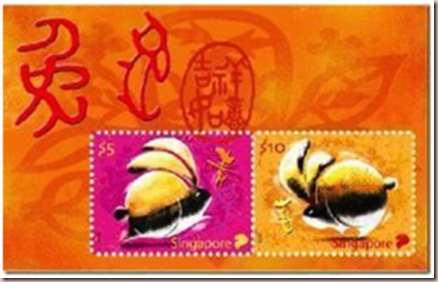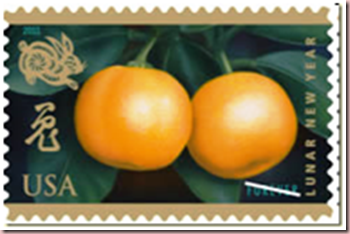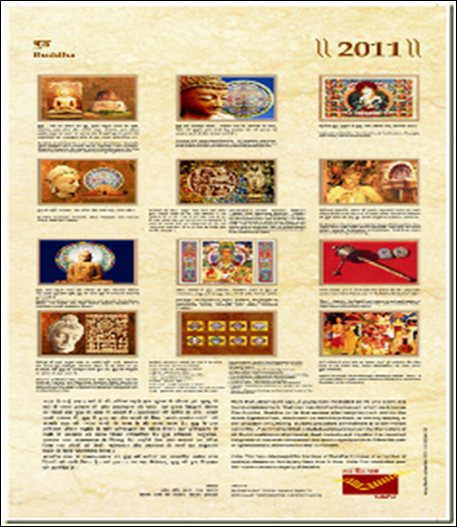Shimla February 2011 Issue # 38 Vol. IV
Monthly e-Stamp Bulletin Edited by Jeevan Jyoti for free circulation among philatelists
Readers are requested to send reports of philatelic activities in their area for publication. Short write ups by the readers about their journals, societies, publications and philatelic requirements can be sent for inclusion in this bulletin to j.jyoti9@gmail.com or rainbowstamp2008@gmail.com and by post to –
Mrs. Jeevan Jyoti, c / o Mr. Ajay Srivastav, Director, Great Himalayan National Park, Shamshi, Distt. Kullu. PIN 175126. (H.P.) India
Note- This bulletin is only for circulation among a limited group of philatelists without any commercial purpose. The bulletin will be sent to the readers only on request. Those who wish to receive it regularly please reply giving the name of your city / country with the subject SUBSCRIBE RAINBOW
Dear Reader,
The Countdown for World Philatelic Exhibition INDIPEX 2011 has begun. The exhibition celebrates the Centenary of the First Official Airmail Flight that took place in India on 18th February 1911. To make this event very special A ceremonial flight would take place on 12th February 2011 from Allahabad to Naini commemorating the 100 years of the Airmail flight. The flight would carry about 5000 First Day Special Covers with special postmark. India Post will issue a special Khadi Stamp and introduce personalized stamp for the first time during the exhibition. This event will bring a great pleasure and enthusiasm for philatelists, from India and abroad to meet at a common place. I wish all the participants and organizers a grand success. Looking forward to meeting you all at INDIPEX 2011…Pragati Maidan, New Delhi…Have a Wonderful & Memorable Time at the World Philatelic Exhibition !! ....
Till next month…Happy Collecting !!
…. Jeevan Jyoti
Contents
![]() Something of interest, also for non-philatelists
Something of interest, also for non-philatelists
![]() New Issues from Other Countries
New Issues from Other Countries
![]() Philatelic Clubs and Societies
Philatelic Clubs and Societies
![]() Current Philatelic Magazines – Newsletters
Current Philatelic Magazines – Newsletters
Recent Indian Issues
![]() 15 Dec India – Mexico Joint Issue – Rs 5, Rs 20 + MS
15 Dec India – Mexico Joint Issue – Rs 5, Rs 20 + MS
![]() 21 Dec Crafts Museum – 2 stamps of Rs 5 each + MS
21 Dec Crafts Museum – 2 stamps of Rs 5 each + MS
![]() 22 Dec Yashwant Rao Chavan & Bhausaheb Hiray – two stamps of Rs 5 each
22 Dec Yashwant Rao Chavan & Bhausaheb Hiray – two stamps of Rs 5 each
![]() 23 Dec Bhai Jeevan Singh & Central Bank of India – two stamps of Rs 5 each
23 Dec Bhai Jeevan Singh & Central Bank of India – two stamps of Rs 5 each
![]() 24 Dec National Council of India & Dr Triguna Se- se-tenant pair – Rs 5 each
24 Dec National Council of India & Dr Triguna Se- se-tenant pair – Rs 5 each
![]() 31 Dec – two stamps - Immanuel Sekarnar & Lalit Kala Academy – Rs 5 each
31 Dec – two stamps - Immanuel Sekarnar & Lalit Kala Academy – Rs 5 each
![]() 27 January 2011 : Krishnadevaraya – Rs 5 + MS
27 January 2011 : Krishnadevaraya – Rs 5 + MS
2011 Stamp Issue programme of India Post is available at following link.
http://www.indiapost.gov.in/Netscape/PhilatelyCalendar2011.htm
Special Cover – Postmark
16 December 2010 : Mandipex 2010, Sundarnagar (HP) - Namdhari Shawl – Badahan, Kullu
31 December 2010 : Golden Jubilee Year of National Geophysical Research Institute. Jama-I-Osmana PO
1 January 2011 : Chennai - Centenary of South India Chambers of commerce & Industries.
4 January 2011 : 6th National Jamboree and Centenary year of Guiding in India, Shankarpally PO
5 January 2011 : Daroji Sloth Bear Sanctuary – Permanent pictorial cancellation, Kamalapura
6 January 2011 : 26th Scout – Guide Jamborette af Karnataka , Tharalu
11 January 2011 : 150 Yrs of arrival of train at Vadodara
15 January 2011 : Sarpex 2011, Chupra – Rajendra College
16 January 2011 : Sarpex 2011, Chupra – Gajgrah Sonepur Fair
23 January 2011 : Chennai Builders’ Association of India, Southern Centre
In The News
Forthcoming Philatelic Exhibition
INDIPEX – 2011
The world philatelic exhibition will be held in New Delhi from 12th to 18th Feb. 2011, to commemorate the centenary of world's first airmail. It will be organized by INDIA POST in Collaboration with PCI and under Patronage of FIP and under auspices of FIAP (Federation Inter Asian Philately). The list of Indian Jury members is given below :
Sunder Bahirwani - Secunderabad, A.P.
Ms. Damayanti Pittie - Mumbai
Mehta Dhirubhai - Mumbai
Mr. Dastur Vispi - Mumbai
Mr. Dilip Shah - Jabalpur
Mr. Ajeet Raj Singhee - , Hyderabad
Mr. Yogesh Kumar - Baralie (U.P.)
The details of INDIPEX 2011 can be found on following websites -
http://www.indipex2011.com/ & http://www.filatelista-tematico.net/india2011.html
Special Highlights of INDIPEX - 2011
Commemorative Flight on 100 years of Airmail
The exhibition will largely focus on Aerophilately as India Post celebrates the Centenary of the First Official Airmail Flight that took place in India on 18th February 1911. A ceremonial flight would take place on 12th February 2011 from Allahabad to Naini commemorating the 100 years of the Airmail flight. The flight would carry about 5000 First Day Special Covers with special postmark; a collector’s delight being limited editions. The special stamp carrying the special cancellation would be released on 12th February, 2011 to commemorate the event.
The First Official Airmail Flight
Although airborne mail transport had occurred during the nineteenth century, the first Official Airmail was flown in India in 1911.
On February 18, 1911, French pilot Henri Pequet (1888-1974) carried the official airmail; a sack with about 6,000 cards and letters on his Humber biplane. The plane flew a distance of five miles, from an Allahabad polo field, over the Yamuna River, to Naini. All mails were marked with a large magenta cachet showing a plane within a double lined circle, inscribed “First Aerial Post — 1911 — U.P. Exhibition Allahabad“.
Pequet was in India flying demonstration flights for the United Provinces Exhibition in Allahabad. Walter Windham (1868-1942), a British aviation pioneer, organized the aerial demonstrations. The event marked the first time airplanes flew in India.
Special Stamp Release
The Khadi Stamp : Presentation Pack
India Post on the occasion of INDIPEX 2011 is bringing out a special stamp on Gandhi Ji to commemorate the event. The stamp will be unique as it will be printed on "Khadi", the handspun cotton material that Gandhi Ji held as the symbol of self determination and self reliance.
The Presentation Pack will be released by Smt. Pratibha Patil, the President of India on Saturday 12th February 2011 at INDIPEX 2011, the World Philatelic Exhibition being held in New Delhi, the capital of India.
The Presentation Pack
The Khadi Stamp will be available during the exhibition at the venue, as a Presentation Pack which will also include a miniature sheet. The Presentation Pack is priced at Rs. 250 only and a maximum of 10 stamps can be ordered by a single person.
Orders for this special stamps can be placed by writing directly to Mr A.S. Kala or pre-ordering them online. Outstation orders will be sent by Speed Post for which necessary charges will apply.
The deliveries would start from 12th February 2011.
Read more details : http://www.indipex2011.com/?page_id=381#form
My Stamp
Your Personalized Stamp
One of the most exciting feature of the exhibition is the My Stamp which is being introduced by India Post for the first time in India. Also known as ‘Personalised stamp‘, My Stamp is a wonderful way to celebrate special occassions such as engagements, birth of a baby, or to send as greetings to loved ones and friends.
Personlized Stamp in 3 Steps!
1 . Get your photograph clicked or carry any other photo on which you wish to create your personalised stamp.2 . Choose the template and the theme.3 . Get your My Stamp ready in print.
The template on My Stamp would be printed on the six themes:
1 . Trains 2 . Aeroplanes 3 . Wildlife 4 . Panchatantra 5 . Sun Signs 6 . Taj Mahal
Each template is designed on one of the above themes and has 12 personalised stamps perferated on it. One can get their personalised stamps on their favourite photograph on all of the themes mentioned above.
The Philatelic Passport
Having more than 70 countries participating at this exhibition, with a Philatelic Passport, collectors need to travel from country to country by visiting sales booths to buy the stamps and obtain the special datestamp cancellations of that participating country. When it is done, one will have completed his travel around the world. This is very exciting as the activity of traveling through the world would take place at just one venue which is the World Philatelic Exhibition at Pragati Maidan, New Delhi.
The philatelic passport has stamps with full postal cancellations on each page. These stamps together with the passport will be worth much more than the individual used stamps when removed. There are collectors of these passports.
Philatelic Passport aims to create enthusiasm amogst children, stamp lovers, philatelists and visitors. The passport can be obtained from the exhibition directly.
Souvenir
See more details : http://www.indipex2011.com/?page_id=347
PHILANIPPON 2011
World Stamp Exhibitions are held all over the world every year with aims to develop philately, opening world-renowned stamp collections to the public and promote stamps of the member countries of the F edration Internationale de Philatlie (FIP). In Japan, World Stamp Exhibition takes place once every ten years and held in 1971, 1981 and 1991, and 2001, and will also be held in 2011.
The theme of PHILANIPPON 2011 is “Stamps Link the World”. It will be a rare opportunity for the first time in 10 years in Japan to promote philatelic culture in Japan, publicize Japanese stamps overseas and nurture cultural exchange and international friendship through stamp collection.
Date : July 28 – August 2, 2011
Venue : Pacifico Yokohama, Exhibition Hall.1-1-1.1 Minatomirai Nishi-ku,
Yokohama 220-0012, Japan
Patronage : Fédération Internationale de Philatélie (FIP)
Auspices : Federation of Inter-Asian Philately (FIAP) http://www.philanippon.jp/english/
Namaste ! Hello from Royal Mail
Royal Mail have announced the issue of an Exhibition/Generic Smilers sheet for Indipex 2011 The sheet consists of two identical halves each having images of old and new Delhi, and the British 1969 Gandhi Centenary stamp, on labels alongside the self-adhesive Union Flag stamp.The sheet will be on sale from the Royal Mail Philatelic Bureau and philatelic outlets from 12 February.
World Online Philatelic Agency - launches the first international face value stamp site
A dream has come true for stamp collectors around the world as it is now possible to buy at face value and on a single site (www.wopa-stamps.com) the new issues and all available stamp products from a variety of postal administrations, including Aland, The Faeroe Islands, Gibraltar, Guernsey (with Alderney), Jersey and Isle of Man. Furthermore additional countries are being added all the time and already confirmed to be available within the next weeks are Great Britain, Luxembourg, Israel and Portugal (with Azores and Madeira). The site will also offer philatelic accessories related to the participating countries produced by the Dutch company DAVO.
Stamp Art Fever – A game for stamp collectors
27 Jan. 2011 Pisa, Italy, Independent software developers Francesco Chessari and Nicola Pacini are pleased to introduce Stamp Art Fever 1.0.1, their new simulation game for iOS devices. In Stamp Art Fever, you are a stamp collector continuously searching for new pieces to add to your collection.
Probably as far back as 1839 Sir Rowland Hill did not think that its reform of the postal system would have inspired the creators of this game for iPhone/iPod. The Famous Penny Black was the first of countless stamps used around the world to send letters carrying news of all kinds. Soon, collectors around the world began to take care of them and rare specimens acquired an enormous economic value.
Stamp Art Fever revolutionizes your virtual world, great graphics and a perfect game of chance allows this application to become a must have. Download it immediately and begin to categorize your stamps. You have several ways to get the stamps you are looking for: the Philately and the Black Market. The game is enlivened by events, such as fire and theft, which could slow down your career.
Queen Victoria stamps set Hong Kong record
| A quartet of the most important stamps in Hong Kong philately sold Sunday for a record 6.4 million Hong Kong dollars (US$820,000) to an anonymous Asian buyer. The extremely rare 1865 96-cent stamps in mint condition features a profile of Queen Victoria. The image is based on sketches made by Sir Hercules G. R. Robinson, governor of Hong Kong from 1859 to 1865 (the city’s Robinson Road is named after him). The block was sold by Spink, a London-based auction house, during a sale of rare stamps, coins, bank notes, bonds and shares Saturday and Sunday at the Landmark Mandarin Oriental in Hong Kong. The block is noteworthy to collectors for three main reasons: It was printed in early 1865, when stamps and stamp collecting were in their infancy. Its color — olive-bistre, in philately-speak — was a mistake, due to an error by the printing company De La Rue in London. Because of the color error — they were supposed to be a brownish-gray shade — only 52 sheets were printed, which makes them rare: Only 48 unused examples of this particular stamp exist today, according to Spink. The other 36 are believed to be single stamps, and this particular block of four the only multiple set of unused examples. This block, highly coveted by collectors of Hong Kong stamps, was previously owned by well-known philatelists such as George Burghard of New York, Ryohei Ishikawa of Tokyo and Richard C.K. Chan of Hong Kong. It has appeared at auction only twice before, the last time in London in December 1980. The purchase of this block by an anonymous Asian investor is part of a massive shift of Chinese collectibles back to China from the West. http://blogs.wsj.com/scene/2011/01/25/the-820000-stamp/ Malaysia kicks off largest stamp fair |
KUALA LUMPUR, Jan. 18 (Xinhua) -- The largest stamp exhibition in Malaysia's history kicked off at the National Museum in Kuala Lumpur , expecting to attract some 300,000 visitors to the fair that ends on March 25.
Penny Black, the first adhesive postage stamp issued in Britain since 1840, and the signed-Malaysia state royal first day cover, the first of its kind introduced last year during the installation of a state ruler, are among the 50,000 philately on display at the museum.
The stamp exhibition also showcases stamps and first day covers from around the world, telling stories about historical events.
The museum, together with Malaysian Information, Communications and Culture Ministry, local post services company and the National Philatelic Association jointly launched the exhibition in Kuala Lumpur on Tuesday. The event has drawn attention of philatelists and curious crowd.
| While some philatelists commemorated important events that happened in the Association of Southeast Asian Nations (ASEAN), such as the admission of Cambodia into the regional bloc in 1999, others bragged about the multi-ethnical and cultural environment in Malaysia. |
Philatelic Exhibition on Railway theme at Vadodara
As a part of celebration of 150 years of arrival of railway at Vadodara, non competitive philatelic exhibition on Railway theme was organized from 11th January to 13th January 2011 at Railway Auditorium by Divisional Railway HQ, Western Railway, Vadodara with support of India Post and Baroda Philatelic Society. Shri R. N.Verma, General Manager of Western Railway inaugurated the exhibition.
Exhibits on railway theme were displayed in 18 Frames including one frame of Match Box labels on Railway theme. Original Print of Illustrated London News dated 23rd May 1863 which published news about the introduction of Bullock Tram between Dabhoi - Miyagam in Baroda State in 1862 was also on display. India Post has opened philatelic counter at the exhibition for sale of philatelic material.
A Special Cover was also released on the occasion to mark 150 years of arrival of railway at Vadodara. Special Cover was released by Postmaster General Lt. Col. D. K. S. Chauhan of Vadodara Region and presented to Shri R. N.Verma, General Manager of Western Railway. Special Cover depicts old railway station of Vadodara, railway route of 1870 and newly constructed railway station building towards Alkapuri (West Side of Vadodara). Cancellation design depicts newly constructed railway station building towards Alkapuri. Special Cover and Cancellation were designed by Mr. Sapan Jhaveri and the concept of designs was of Mr. Prashant Pandya
Queen’s Head to Stay on Stamps
The Queen’s head will remain on stamps regardless of who buys the Royal Mail after the UK Government decided to amend its controversial privatisation legislation according to an article by Alan Jones on Britain's Press and Journal website.
Alan pens, "The government said that after listening to the views of members of both houses of parliament and raising the matter with Buckingham Palace, it had decided to build in a new safeguard.The Postal Services Bill, which receives its third reading in the Commons on Wednesday, will be amended to give ministers the power to require an image of the Queen to appear on postage stamps."
Postal Affairs Minister Ed Davey is quoted in the piece as saying, “At the moment there is no legal requirement for stamps to use the Queen’s head. Royal Mail has always done this voluntarily by convention as they are extremely proud of their royal connection."
Moya Greene, Royal Mail’s chief executive, is also quoted and points out, “The monarch’s head has been a key feature of Royal Mail stamps since the Penny Black was issued in 1840. We are very proud of our longstanding royal association. It’s unthinkable that Royal Mail stamps would not have the image of the monarch so we strongly support any measure that fully protects that key feature of our stamps.”
Shown above, the original 1966 photo of Queen Elizabeth II by John Hedgecoe which she approved for use on postage stamps in the UK and throughout the Commonwealth. Printed billions of times over the last four decades, it is likely that this is the most reproduced image in history.
NEW YEAR MEET OF CENTRAL INDIA PHILATELIC SOCIETY
Central India Philatelic Society is the leading Philatelic organization of M.P. It was established in the year1974 and organized more than 20 National / Regional Philatelic Exhibitions at various places. Lot of special covers, folders, souvenirs etc. have been published by this Society. Monthly meetings of the Society are being organized on the first Sunday of the month at the residences of its members. New Year Meet and first Monthly meeting of the year 2011 was organized on Sunday 2nd Jan. 2011 at Satna (M.P.) at the residence of Secretary Mr. Sudhir Jain. It was well attended by the members of Satna, Rewa, Maihar, Panna etc. Meeting was presided by the Society President Mr. Ramesh Lajpatrai. Joint Secretary Mr. Rajendra Agarwal "Shashi" welcomed all the members and P.R.O. Mr. Thakur Khilwani presented Report of the activities of the Society during the whole year 2010.
Promoting Philately in a different way ..
 Mr RD Mathkar, a philatelist from Mumbai is doing a remarkable service for the promotion of philately. Recently he gifted packets containing about 3,500 stamps of India & other countries for distribution amongst school children of Our Lady of Remedy High School,Poinsur, Kandivali (West) Mumbai. Apart from collecting stamps and exhibiting the exhibits on water birds in different stamp exhibitions, he tries to encourage school children in stamp collection. He believes that children should develop this hobby, to learn more about this beautiful world. Some renowned philatelists helped him in this endeavor. Mr Mathkar may be contacted at email : ravimathkar@gmail.com
Mr RD Mathkar, a philatelist from Mumbai is doing a remarkable service for the promotion of philately. Recently he gifted packets containing about 3,500 stamps of India & other countries for distribution amongst school children of Our Lady of Remedy High School,Poinsur, Kandivali (West) Mumbai. Apart from collecting stamps and exhibiting the exhibits on water birds in different stamp exhibitions, he tries to encourage school children in stamp collection. He believes that children should develop this hobby, to learn more about this beautiful world. Some renowned philatelists helped him in this endeavor. Mr Mathkar may be contacted at email : ravimathkar@gmail.com
Special Covers to be numbered
Various Postal Circles were issuing a huge number of special covers. One does not have any track on special covers. Now Department of Post has issued instructions to its Postal Circles that all the special covers should be serially numbered.
STAMP COLLECTORS’ MEET
February 12-14, 2011
Venue: National Sports Club of India, Opposite Pragati Maidan, Mathura Road, New Delhi 110001
Timings:
Feb 12 Saturday - 12 noon to 6pm
Feb 13 Sunday – 12 noon to 3 pm Feb 13 Sunday – 3.30 pm onwards Auction
Feb 14 Monday – 12 noon to 5 pm
Contacts: Ashish Talwar 09810186108 talwar2002@hotmail.com ,
Rohit Prasad 09810304233
JAINISM PHILATELISTS MEETIND ON 15th FEB. 2011 AT DELHI
A meeting of the Philatelists collecting JAINISM and allied theme is organized on Tuesday 15th Feb. 2011 at 4 P.M. at the INDIPEX-2011 exhibition venue at Delhi. Philatelists are requested to attend the same. Those who are planning to attend this meeting, please inform on the following mobile numbers or by E-mail at mrsudhirjain@yahoo.com so that we could know tentative number of participants-
09894252549 (Mr. Pramod Kumar Jain, Pondicherry)
09425554530 ( Dr. Pradip Jain, Balod),
09425174190 (Sudhir Jain, Satna)
INTERVIEW
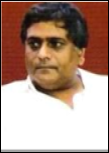 Anil Dhir is a popular name in philatelic Community. His varied interests and achievements in different fields of philately make him very special. His short film “The Last Post” has won many awards at different exhibitions. He has written a detailed book “Stamp Quizzes” containing 1500 questions and answers. His two books Famous Stamps of the World and A Glossary of Philatelic Terms. Besides his work in the field of Philatelic Literature he is also an ardent philatelist and has prepared extensive collection on Indian Classics, Great Britain and Mourning Covers. His exhibit “Edged in Black “ is a specialized collection of Mourning Covers which has been awarded and highly appreciated in the exhibitions.
Anil Dhir is a popular name in philatelic Community. His varied interests and achievements in different fields of philately make him very special. His short film “The Last Post” has won many awards at different exhibitions. He has written a detailed book “Stamp Quizzes” containing 1500 questions and answers. His two books Famous Stamps of the World and A Glossary of Philatelic Terms. Besides his work in the field of Philatelic Literature he is also an ardent philatelist and has prepared extensive collection on Indian Classics, Great Britain and Mourning Covers. His exhibit “Edged in Black “ is a specialized collection of Mourning Covers which has been awarded and highly appreciated in the exhibitions.
The latest book “Famous Stamps – The Romance of Rarities” by Mr Anil Dhir is a very interesting book, full of stories of some most famous and rarest stamps of the world. The best part of the book is that the story behind rarity of the stamp has been narrated very well by Mr Dhir. Many of us know about rare stamps but the detailed story behind that stamp is not known to us. Readers would find many interesting facts about world’s rarest stamps. This book contains details and stories of 50 famous stamps and covers of the world and it is a complete reference book for philatelists of every class and age groups . Those who are not stamp collectors would find this book amazing as they would come to know about philatelic rarities of the world and interesting stories behind them.
Mr Dhir hails from Bhubaneshwar, is a finance executive and spends all his spare time in activities that involve interaction with mavericks, downtrodden and the castaways. He has, over the years traveled extensively all over India, mostly off the beaten track. He has worked among the Juang and Kandha tribals of Orissa, the fisher folk of coast. Indian National Army veterans.
It is a great pleasure to publish an interview with Mr Dhir. Here he explains some other aspects of philately which readers would really like to know. - Editor
 How I was introduced to Philately….
How I was introduced to Philately….
I was introduced to philately at the age of eight by my stamp collecting grandfather. He had an album full of stamps and gave me the weeds. My first album was the simple Stamps of the World Album which had one page per country, and a few unmarked pages in the end. I think it started with Aden and ended with Zanzibar. I remember that there was a printed image of a stamp in each upper corner and underneath the country’s name and little information on it. The continent, population, capital city, currency etc were printed on the top of the page. It was so difficult to hinge the stamps them properly in the squares provided.
I graduated to serious philately once I was in college. Ever since then, with a few intermittent years, it has been journeys to Post offices, old record rooms, old palaces etc. I have been lucky to get my hands on some excellent early India stamps, but I woe the many that got away. I must have soaked off so many valuable covers in sheer ignorance. I had the Lithos by the hundreds, but most of them were given away or exchanged.
It has been a continuous never ending journey….
Mr Anil Dhir may be contacted at email : anildhir2k5@hotmail.com
Interview with Anil Dhir
Q1. You have a variety of interests in philately....from writing, collecting to film making....How were you inspired to film making ??
I have a variety of interests, just not philatelic but even otherwise. I will say that the film was not made, it happened. I happened to be in the right place at the right time, one thing led to another and the film was made. Sometime I think back and realise how foolhardy I had been to venture into territories about which I did not know anything. To make the 22 minutes film, I had to shoot nearly 40 hours of footage.
Q2. Your film Last Post has got immense popularity in India & abroad. How did you get the idea to make this film ??
It was something that was so unique that I wanted others to know about it. I could have written on The Dak Tonga, but the small picturesque town with its simple people and their stories, the old world charm of its aging palaces and buildings – all enthralled me. I wanted to capture the spirit behind this man and his tonga and translate it into imagery. You will be surprised to know that I have never handled a Camera before, it was a first time that I was looking through the viewfinder.
I did write pages on the story of the Tonga man, his cart, the postal system and the little town and its history. The book is still unfinished, I tried to finish it, but strangely I make headway only when I visit the place. During my last visit to Jeypore a month ago, I sat up the whole night and finished twenty pages. Maybe I will finish it this year. The book too will be called “The Last Post”.
Yes, the idea of filming his life came to me because I realised that whatever I wrote about him, be it a book or an article, would be soon forgotten. A film would have a wider reach. However Nila Nayak was a very reticent and a bitter man of very few words. He would just not open up. It took me a good one week to befriend him. I still remember the nights when he would take me on a long Tonga ride along the Jagganath Sagar pond in the city. He would hit the bottle and then tell me his sad story. I being teetotaler had to pretend that I too was drunk.(A empty beer bottle with sprite).
I worked with him on the mail runs. I loaded the mail from the post office and carried it up the roof of the buses. Nila would also hand me the reins and the horses too had accepted me. It was a pity that he did not get to see the film. His sudden death was a very saddening experience for me. More so, because he had not told me his entire story.
Q3. You have a nice collection of Mourning covers " Edged in Black " ?? Any specific reason to collect these covers ??
I have been a maverick all my life. I like treading on the untrodden path. A chance discovery of a Mourning cover with its black borders got me going. There was hardly any reference available. I found out the significance of the colour Black and mourning. I did a lot of study on Victorian customs and social mores. I have found out only two other persons in the world who collect Mourning Covers.
There are so many similarities in mourning all over the world. The custom of tearing and destroying letters that have conveyed messages of death is prevalent all over the world. People do not preserve funeral notices and letters that have got messages of death. The difficulty of collecting these covers is something which goes over the heads of most of the Juries at the Exhibitions. I am surprised that the highest I have got is a Large Silver. No body can understand how difficult it is to get together something which is customarily never preserved.
Collecting Mourning covers is a very challenging endeavor. In no culture or country do people hold on to these letters. It took me ten years to build up a five frame collection bit by bit. I have got nearly 5,000 covers, postcards, funeral notices, elegiac letters, gravestone and coffin receipts. These span from a period of 1823 to the present day and I have covers from 126 countries.
Many people have written to me and asked me why I have such a morbid hobby. Some have even told me that keeping such letters brings bad luck.I got a letter from Khuswant Singh commenting on the morbidity of my collection. In fact I took my collection and showed it to him at his house in Delhi. He was amused and extracted a promise from me that I would issue a cover on him after his death. If I outlive him, this is one promise that I shall keep.
Q4. Would you please tell about some most important covers in your "Mourning Covers" collection .
I have a few Return to Sender covers of the World War I & II. They are so pathetic and tragic and have a story to tell. The missing in Action covers are also very heartbreaking. These are letter posted to soldiers, but could not be delivered as they had died in action. The Military Post would put black markings on these letter and return them to the sender with the missives like “Missing In Action: Presumed Dead”.
I feel like a voyeur when I read the death messages, some of them are so sad and heart touching. Most of the covers I have had the original letters inside them. Some have stories to tell. One set of about 40 covers were posted from the same person to the same address and contained forty letters spanning over two years. How a woman copes with the loss of her husband , how she gradually reconciled to grim reality of death all unfold in the letters.
I had made a mourning cover on Saddam Hussein the day he was hanged. The covers were posted both to Tony Blair and George Bush and the Washington Post and New York Times had both carried the story. It seems I was the only person to mourn the death of Saddam Hussein officially. The cover now sells in eBay for $100.
I have got a early cover with a strip of four Penny Blacks. The envelope was over stamped and the black stamps and the Black borders complement each other. I was offered $5000 for it, but as of date it still stays in my collection.
Q5. What are your other collecting interests besides collecting "mourning covers" ?
I have the early Indian Classics, Great Britain, Indian States, Early Philatelic Stationery, Ships and a cornucopia of other philatelic materials. I have with me more than 100 letter boxes of all shapes and sizes dating from the last century. Besides I also have badges, weighing scales, hand stamps, uniforms, pedometers, post bags etc. I would like to give them away to form a museum as it is beyond my scope and limit to do so. Besides I have got a library of more than 500 philatelic books.
Q6. You have written two books, one on Quizzes and other on famous stamps of the world. It is a great achievement .What inspired you to write books on stamps?
I was inspired to write the book by Smt. Indira Krishna Kumar who was the Chief Postmaster General of Odisha. The India Post officials would call me very often to conduct quizzes in Schools. I thought that if a book on quizzes was written, then it would be helpful for them, as they would be able to conduct the quizzes themselves.
India Post purchased more than 500 copies of the book. In fact I sold out all the thousand copies in two years. I am reprinting a revised and updated edition later this year.
The second book was my tribute to this great hobby. I have written about famous stamps and given the stories behind them. This book too has been accepted well by the philatelic community. Two more books are underway. One is on the INA Stamps and the other on the Scinde Dawks. I have also written a monograph on the stamps of Bamra which will soon be bought out.
Q7. Thematic Philately has emerged as the most dominant class in the exhibitions today and in all the exhibitions the judging of this class has always become very controversial.....As often many good exhibits in the exhibition do not get proper award and recognition. What is your opinion and suggestion to make changes in the system of judging so that the exhibits could be judged fairly.
The scope of Thematic Philately is limitless. Why not have a system where peer judging is done? Philatelists themselves too can give their marks to the exhibits while they go around the exhibits. The old school of Philatelists in India, who form most of the Jury Circles are a shortsighted peripatetic lot with very limited knowledge of Postal history, thematic subjects, literature etc.
In my opinion, to be a good Judge, one has to study the hobby in theory. Just being a collector who has either purchased or inherited a collection does not give the knowledge and depth that is required to judge a Thematic collection. In India the syndrome of “you scratch my back and I’ll scratch yours” is all prevalent in the Jury selections.
Q8. A new trend has started of holding philatelic exhibitions by private clubs and societies. Do you think the exhibitions at private level should be organized ?? As limited finance and frames are the main constraints in these exhibitions as compared to the exhibitions organized by Deptt. of Posts...So sometimes organizers fail to arrange required number of frames and some exhibits are left un - exhibited causing dissatisfaction among the participants .
The root of the problems lies with India Post. If they hold periodic exhibitions at the District, State and National levels of fixed calendar basis, the need for private exhibitions would not arise. But the trend of late, (with due apologies to India Post) has been that these private exhibitions have drawn excellent response from the philatelic community. It would not be wrong to say that these are being held in a very professional manner and the participants too are a happy lot.
Understandably there is a financial constrain at the club and society level exhibition, but India Post should take a few lessons from these events. Even with the limited resources, the private exhibitions being held have been a success. Stampmania, SINE etc are all recent examples. India Post spends a big budget for its official events, but there are glitches galore.
It would be good if India Post funds these privately held exhibitions on a partnership basis. The harvest is eventually reaped by them, as the bucks stops there. Every event which promotes philately directly earns revenue for India Post.
Q9. What is your opinion about the quality & quantity of Indian Postage stamps and Postal stationery?? Do you think that number of stamps issued per year by India Post should be reduced and quality of the stamps and postal stationery need to be improved ??
The vast Diaspora that our Nation is, representation of its unique aspects on Stamps is limitless. The number of Stamps issued should be increased, along with a marked improvement in the quality. The quality of Postal Stationery is very poor, but we have to remember that the revenue earned on most of the Stationery is very low.
Q10. Last but not the least ....Internet has become a good medium of information among philatelists. But do you think if this hobby is really developing ??? Most of the exhibitions and stamp fairs have become centre of business instead of an event to promote this hobby ?
The hobby is stagnating and ossifying. Philately is a dying hobby if the new generation does not take up the hobby, it will end up as an investment tool, with people investing in stamps only for the financial gain they would bring with age. Even today, financial consultants are recommending investors to put money in stamps as the returns are relatively higher.
That the stamp fairs and exhibitions have become business centers is true. But on the flip side, this will bring many more people into the hobby. Internet has certainly helped in promoting philately. Now virtual stamps are the new catch word.
Beginners’ Section
A STAMP EXHIBITION AND YOU
 - Vipan Kumar Thakur, Chandigarh
- Vipan Kumar Thakur, Chandigarh
A philatelic exhibition is organized to promote and disseminate information about Philately. It is a wonderful event and a delightful thing to all the philatelic stake-holders, viz. the collectors, the dealers, the philatelic journalists and publishers, the designers and security printers, and the postal administrations who issue stamps and stationery. It will stimulate a keen interest for philately. It is educative and will surely increase your G.K. It is also likely to create lasting friendship between you and philately.
A philatelic exhibition is a great spectacle for all stamp lovers where the philatelists display their wide range of precious collections of stamps under one roof and is available for public viewing. This event is organized at some important place in your city.
The philatelic event may be of World level, National level, State level or District level. The World level and National level Philatelic Exhibitions have thousands of frames. A first look at it, over whelmed you and registers a feeling of confusion in your mind, because you find yourself standing in a jungle of frames, which are planted in so many rows in different patterns. It might not be possible to see all the frames. Go through the programme of the exhibition and display plans. There are the number of exhibits, some on science, some on history, some on culture, some on tradition, some on flora and fauna etc. Make a selective list. So make a more effective choice of what to see, and what not to see. This will help you in properly planning your approach and enjoying the same to full extent.
Always start with those, which are related to your stamp collection and which attract you most. There might be exhibits of some prominent philatelists and some rare items on display, be sure to include in your programme even though they may not be falling under your specialization. Reserve some time in your schedule to see the classics exhibits, exhibits in invitation class, Court of Honour Class, Exhibits of Postal Administrations, Collection of the members of the Jury (by invitation only, if any) and prize winning exhibits after the announcement of awards and of course do not forget to see the ‘The Best Exhibit, prize winning exhibit.
Observe and examine the selected exhibits carefully and note down the following points:
i. the items displayed on the theme
ii. the way it is presented.
iii. the leading idea of the exhibit.
iv. how they have been related to the theme.
v. the way it has been written up.
vi. General impression of the exhibit.
If it appears to you that there is something unique, uncommon or some new idea presented, and then bookmark it in your mind.
Note down important points – they will be in handy when your memory begins to fail you and the exhibition is long dismantled. Compare the exhibits and try to form your own views and judgments about their relative merits. Note that even the common stamps become as useful as rare items on an exhibit on account of depth study and research done by the exhibitor. Similarly, relevant cancellations may also serve the purpose of stamps on an exhibit.
Examine the above thoughts and various other aspects of presentations. What you observe, see and learn from the exhibition is going to be a milestone in your serious and eventful philatelic career. After seeing a philatelic exhibition it may appear to you that there is hardly anything that you can do with your stamp collection; after giving some thought, it is sure that there is something pleasant you can do with it, no matter what you have in your collection.
Sometime you can take time to compare your stamps with what you have seen at a philatelic exhibition, other times you may only be able to have a sight of them and be pleased, even though the same is for a short time. Still other times the only thing you may be able to do is to change your own thinking about your stamp collection and this can end up being a significant positive step and which may enthuse you to exhibit your collection in a better way.
If you throw your hands in despair or frustration, it will not take you anywhere. The more effective choice is to know, without a doubt, that there is something you can do with your stamps, and to then get busy with them. A best stamp collection exhibit is made not by chance, but by choice.
God gave us two ends, one to sit on and one to think upon (about your stamp collection also) and act. Success depends on which one you use, head you win and tails, you do not lose. So not only think but plan also and not only plan but act also and you will met with success and see your own exhibit at the next philatelic event. It will be a thing of beauty to joy forever and a best heritage to bequeath to your children.
Good luck and enjoy philatelic exhibition.
Specialized Section
THE STORY OF PIGEON POST
AVIAN ALLIED FORCES FOR THE AUSTRALIAN,U.S. AND BRITISH ARMIES
British Army
During WW1 the British Army had a unit called the Carrier Pigeon Service (CPS) which was led by Lt. Col. A.H. Osman. Carrier pigeons were used by the Brits during the Second Battle of Ypres in May of 1915. The Carrier-Pigeon Service was only used when telegraph and telephone communications failed and was soon overtaken by the development of Wireless Telegraphy (i.e. Radio), further limiting their usage; hence, they were only used for emergency or espionage purposes. The avian unit saw further success at the Battle of the Somme and at Verdun, often against screens of poisonous gas and heavy shelling from the opposition.
U.S. Army
The U.S. Army used specially trained homing pigeons to carry messages during WWI and WWII. They were considered an undetectable method of communication. Fort Monmouth, New Jersey was the home of the U.S. Army Pigeon Breeding and Training Center from 1917 until 1957. A small capsule would be placed around the leg of the pigeon and a paper message was put into the capsule. The bird would be released to fly to its home loft with the message.
Pigeons have been known to fly hundreds of miles in a day with a mile a minute being the average speed. Military historians claim that over 90% of all messages sent by the US Army using pigeons were received. Pigeons were also used to carry maps, photographs and cameras. The birds are credited with saving thousands of lives. The U.S. Army discontinued using pigeons as message carriers in 1957 due to more modern and faster transmission methods.
WORLD WAR II AND LATER
During WWII, the United Kingdom used about 250,000 homing pigeons. The Dickin Medal, which is the highest possible animal's decoration for valor, was awarded to 32 pigeons, including the United State Army Services's G.I.Joe and the Irish pigeon Paddy.
The UK maintained the Air Ministry Pigeon Section in WWII and for a while thereafter. A Pigeon Policy Committee made decisions about the uses of pigeons. The Head of the section, Lea Rayner, reported in 1945 that pigeons could be train to home any object on the ground when air- released in the vicinity. And hence Bacteria might be delivered accurately to a target by that means. With the latest developments of explosives and bacterial science it was suggest that that possibility should have been be closely investigated and watched. A thousand pigeons, each with a two ounce explosive capsule, landed at intervals on a specific target might be a seriously inconvenient surprise.
The ideas were not taken up by the committee, and in 1948 the UK military stated that pigeons were of no further use.
However, the UK security service M15 was still concerned about the use of pigeons by enemy forces. In order to prepare countermeasures, they arranged for 100 birds to be looked after by a civilian pigeon fancier, up until 1950.
CHINA 2005 - 16 WAR II PIGEON S/S BIRD
APOCRYPHAL TALES ABOUT PIGEON IS AS FOLLOWS
"G.I. JOE"
On 18 October 1943, the American homing pigeon "G.I. Joe" saved the Italian village of Colvi Veccia that was scheduled to be bombed by American forces. Communication equipment was down and the only means of stopping the raid was to attach a hastily written message to G.I. Joe and send him to the allied HQ. "G.I. Joe" delivered a message about the planned attack in time to stop the bombing. In order to do so, he flew 20 miles in 20 minutes and his this speedy delivery (within less than 5 minutes to spare whilst the planes were taxiing on the runway) saved over a thousand towns people, as well as 150 British troops that were stationed there. G.I. Joe received the ‘Dickin’ medal for his bravery.
" PADDY"
The Irish homing pigeon " Paddy" was awarded the Dickin Medal after being the first pigeon to arrive back in England with news of the success of the D-Day invasion, out of hundreds dispatched. He flew 230 miles across the English Channel in four hours and five minutes - the fastest recorded crossing.
The medal citation reads,“For the best recorded time with a message from the Normandy Operations, while serving with the RAF in June, 1944.”
FORCES FOR THE AUSTRALIAN, AND BRITISH ARMIES
British Army
32 pigeons were awarded the prestigious Dickin medal, Britiain's highest award for animal valor. Recipients included a bird named "G.I. Joe," who flew 20 miles in 20 minutes with a message that stopped U.S. planes from bombing an Italian town that was occupied by British forces.
Australian Army
The Australian Army made extensive use of pigeons in WWII in New Guinea and the islands. Surrounded by rugged terrain and unusual atmospherics, wireless communications often failed. Bert Cornish was the Aussie behind their pigeon forces. Some 13,500 birds were used in the Pacific theater by the Australian Army. They awarded two Dickin medals to pigeons that aided them in the war.
HONOR FOR WAR CARRIER PIGEONS :
Birds were used extensively during WW1 One homing pigeon, Cher Ami, was awarded the French Croix de guerre for his heroic service in delivering 12 important messages, despite having been very badly injured. During World War II, the Irish Paddy and the American G.I.Joe both received the Dickin Medal, and were among 32 pigeons to receive this medallion, for their gallantry and bravery in saving human lives with their actions. Eighty-two homing
CHER AMI WWI PADDY WWII
pigeons were dropped into Holland with the First Airborne Division Signals as part of Operation Market Garden in WW2. The pigeons' loft was located in London which would have required them to fly 240 miles to deliver their messages. Also in World War II, hundreds of homing pigeons with the Confidential Pigeon Service were air dropped into northwest Europe to serve as intelligence vectors for local resistance agents. Birds played a vital part in the Invasion of Normandy as radios could not be used for fear of vital information being intercepted by the enemy.
SECRET POST OF WWII
22.02.41 card mailed from German occupied Warsaw,Poland to Rus Alexandre Herculano 41 in Lisbon,Portugal. Hans Frank stamp with margins on two sides.
These are various secret addresses that were used during WWII to get mail to and from agencies in the Axis and Allied camps. They allowed people on different sides to correspond and conduct business. There are literally hundreds of such addressed, some to low value civilian organizations, and some to extremely important military agencies. The 22 February 1944 card above was mailed from German-occupied Warsaw, Poland, to Rus Alexandre Herculano 41 in Lisbon, Portugal. Since Lisbon was a hot bed of intrigue as a neutral country on the Continent, there are over 50 such addresses in that nation alone. This particular card would have been picked up and forwarded to the Polish Red Cross in London. This is a very important field and deserves consideration and exploration.
"Secret Office, at the General Post Office," London, England, 1844. Letters were opened and re-sealed in the Secret Office under the authority of the Secretary of State for the Home Department. The Secret Office "is also used as the Money-Order Office. The ordinary business transacted in the room is the keeping of the accounts connected with the order department, and the franking, &c., of official communications."
Old secret military document of World War II. Carried by pigeon post
COMPONENTS OF PIGEON POST
THE PIGEONS :
HOMING PIGEON PRINTED STAMP ON COVER 1994,ROMANIA
THE MAIL :
Details from a Programme for 'By Pigeon Post' at the Royal Artillery Theatre on the 29th of November 1919 - Courtesy Leonie Williams.
INDIA PIGEON MISSIE NAAL WAR …….LOOK
Please waImage not availableOriginal and actual message / missive carried by 1941 Pigeongram from Kalyan to Bombay. The last Para State “I therefore appeal to the public that the Souvenirs carried by the pigeon and thus help the Naval War Purpose Fund”. Rare. Full of advertisement text
CARE, MAINTENANCE AND TRAINING OF CARRIER PIGEONS :
Maintenance of the carrier pigeons was not an easy task to do. Taking care of their feed, their medical examination and treatment, preparation of their lofts needed a specialized team .
WW2: APO 545, LA, 280th Sig Pigeon Sqd. An 1943 APO 545 cover and letterhead from the 3rd Platoon, 280th Signal Pigeon Company stationed at Camp Young, Indio, Calif. The letter talks about training/handling birds and weapons testing. Truly a rare cover and letterhead
TRAINING OF PIGEONS :
Though the pigeons have natural instinct to return to their lofts but for specific purposes they needed training so that they might carry the messages safely and return to their home / loft well in time without any difficulty. They also needed to be trained for safety from the birds of prey and to fly above the battlefield protecting themselves from the gunfire . They were also trained for long continuous flights and to stay against different weather conditions. Along with the training of the pigeons, training for the pigeon masters too was required.
1941: A Ministry of Information pigeon having a film canister attached to its wing examined. Original Publication: Picture Post - 724 - MOI Film Pigeons - unpub. (Photo by Picture Post/Hulton Archive/Getty Images)
These pigeon couriers are members of the last avian postal service in the world – and could give Royal Mail a few ideas. The birds, from the U.S. city of Fort Collins, Colorado transport digital images of intrepid white water rafters to be processed in what is known as the ‘Pigeon Express’. They fly from the top of the Cache La Poudre River down to a base at the bottom where thrill-seekers can collect their snaps. The concept harks back to the days before the telegram. The birds are owned and trained by Rocky Mountain Adventures, who fly 19 pigeons five times every day, usually travelling a distance of between 20 and 40 miles. Using the pigeons is quicker than driving down from the river and it solves the problem of producing photographic memories for the white water rafting tourists. It takes them just 20 minutes.” w/ photos
Binding the message chip ,tube,microfilm roll to the carrier pigeon
DISPATCH OF MAIL :
After the message is tied with the pigeon leg or the microfilm roll is fixed or the chip is placed in the wings of the pigeon properly the pigeon was freed / released for the return flight to its loft. Care was taken that the pigeon did not have any difficulty in flying. Care was taken to see that the weight and size of the messages container or the capsule or the tube did nor exceed the specified wt. and size
To be continued……
Naresh Agarwal may be contacted at e mail : nareshkumar1992@yahoo.co.in
JAINISM
Jain religion is very old religion. Its followers believe that Jainism is an “Anaadi Ananta” religion. Anaadi means one which has no starting and Ananta means which has no ending. Jainism is a pre-aryan religion which is preached by the Tirthankars (Gods). Jains believe that in every cycle of times, there are 24 Tirthankars. In the present era, Bhagwan Rishabhnath was the first Tirthankar and Bhagwan Mahaveer was the last 24th Tirthankar.
Ahimsa (non-violence) and Anekanta are the most important principle of the Jainism. Ahimsa is non-injury, physical and mental. One should not hurt others in body, mind and speech, one should avoid directly causing injury to a living being, one should not cause others to commit injury, nor should one consent to the causing of injury. Injury is the hurt caused to a living being intentionally, through negligence or under the impulses and emotional stress. The other important fundamental concept of Jainism is Anekanta. It states that reality is complex. It can be looked at from different point of views. Each point of view gives the picture of reality which is as valid and real as the picture of reality received from other point of view.
Jainism has contributed to the philosophy of life in its insistence that the path way to perfection is threefold. Samyak-Darshana (right faith/right understanding) Samyak-Jnana (Right knowledge) and Samyak – Charitra (right conduct).
There are two main branches of Jain religion – Digambar and Swetambar. Digambar word comprises Dig (Disha/direction) and Ambar (cover/sky). It means only directions are the cover/clothes i.e. without clothes. They worship idols of Tirthankars bearing no clothes. Their saints also do not bear any cloth. Swetambar word comprises swet (white) and Ambar (cover/sky). Their idols are dressed and decorated with ornaments and their sents bear white clothes.
NAMOKAR MAHA MANTRA
NAMOKAR MAHA MANTRA is the principle Cult and Essence of Jainism. This prayer is chanted before every pious work.
NAMO ARIHANTANAM - I bow before thy who conquered the all evils of KARMA - BANDHA.
NAMO SIDDHANAM - I bow before thy who relieved from the pains of REBIRTH, got ENLIGHTMENT and set in MOKSHA.
NAMO AYARIANAM - I bow before thy who teaches and enlightens us the path of MOKSHA.
NAMO UWAJJHAYANAM - I bow before thy who teaches us about RIGHT BELIEF, RIGHT KNOWLEDGE & RIGHT CONDUCT.
NAMO LOYE SAVVA SAHUNAM - I bow before thy who are saints and relieved themselves from the worldly affairs.
AISO PANCH NAMOKARO SAVVA PAPPANASANO - This Panch Namaskar Mantra is the way to keep all the sins away.
MANGALANANCH SAVVESIM PADAWAM HOI MANGALAM - Reading of this creates welfare of all.
JAIN FLAG
During the 2500th Nirwan Anniversary of Bhagwan Mahaveer in the year 1974. this Jain flag was adopted by all the Jain comunity of India. It consists of five different colours and each colour has it's own significance. Red colour denotes Brevity, yellow denotes culture, white denotes peace, green denotes character and blue denotes sacrifice. Jain Pratika is there in the centre.
JAIN PRATIKA
This Jain PRATIKA (Symbol) was also adopted at the time of 2500th Nirwan Anniversary of Bhagwan Mahaveer in the year 1974. The outer line of the symbol denotes the TRILOK (three words) - URDHWA LOK (above sky) is at the top, MADHYA LOK (earth) at the centre and PATAL LOK (below earth) at the bottom. The palm denotes the fearlessness and forgiveness. The wheel is Dharma Chakra in the centre of which word AHIMSA (non-violence) is written in Hindi. Swastika denotes prosperity on which three dots are the characters of human being- SAMYAK DARSHAN (right belief), SAMYAK GYAN (right knowledge) and SAMYAK CHARITRA (right conduct). The crescent denotes the SIDDHA BHOOMI which is the place of immortal souls and the upper dot denotes the SIDDHA, the soul which will not take re-birth. In the bottom a Sanskrit phrase "PARASPAROPAGRAHO JIVANAM” is written which means all the human beings help each other.
SWASTIKA
SWASTIKA is also an important and sacred symbol of Jainism which is the symbol of prosperity. Swastika is an ancient symbol often used as an ornament or a religious sign. It is in the form of a cross with the ends of the arms bent at right angles in a given direction, usually clockwise. The swastika has been found on old buildings, inscriptions, monuments, and coins. Jains still use the swastika as a symbol of good fortune. They use it on doors and thresholds and on the first pages of account books.
Swastika was widely used symbol. The clockwise swastika was adopted in 1920 as the symbol of the National Socialist Party of Germany. As such it came to be one of the most hated symbols in the history of humanity. It came to stand for all the evil associated with the Nazis as they gained control of Europe before and during World War II. After the Allies defeated Germany in 1945, they banned the display of the swastika emblem. It shows that a symbol has only the meaning that people have given it. Even a powerful symbol can lose its meaning if the society dishonors or ignores it for a period of time.
To be continued….
Sudhir Jain is Senior Executive in a large industry based at Satna (M.P.). He collects Stamps, Currency Notes, Match Boxes, Bells, News Papers, Jokers etc. and won medals at several Philatelic Exhibitions for his specialized collection on Jainism. He is Secretary of Central India Philatelic Society, Patron of Indore Philatelic Society and life member of P.C.I. He has written many articles on Philately and edited number of Souvenirs. He is associated with Lions International since 1975 and also office bearer of various Social, Religious and Industrial Associations." Mr Sudhir Jain may be contacted at email : mrsudhirjain@yahoo.com
Something of interest, also for non-philatelists….
LORELEI…. Also in India?
If you happen to visit Germany and have a chance to travel by ship on the river Rhine, from Mainz upwards to Cologne, shortly before passing St. Goarshausen, you will see a stiff protruding rock, almost perpendicular to the current of water, with a majestic altitude of 132 meters. This is that scenic beauty of Lorelei on the Rhine (s.Fig.1).
Fig 1
Many years ago, the German writer Clemens Brentano (1778-1842) was much stirred up by a fantastic vision of “Lore Ley”. In one of his ballads he narrates a story of a beautiful damsel, who sitting on a lofty rock on the river Rhine attracts the passersby and cursing her own beauty, springs down into the river. The Lorelei has become almost immortal in the poem by the much reputed romantic poet Heinrich Heine (1797-1856). Today it is a part of Germany folklore. In his poem he describes Lorelei as a water nymph, transformed out of the mighty rock, overlooking the river Rhine, combing her beautiful blond hair and attracting thereby the sailors on the passing by boats.
Fig 2
The name “Lorelei” comes from the old German word “luren”, which means “murmuring” and the Celtic term “Ley” is for “Rock”, So the translation of the word “Lorelei”, would be “a murmuring rock”. It is said that there used to be a small waterfall in the area, which created the murmuring sound, combined with the special echo, which in turn was amplified by the rock to sound like a murmur, may be, due to urbanisation of the area, this murmur ceased to exist with the time.
Fig 3
Since more than 150 years or more there existed in India, not far away from Quetta, a town called Loralai, which was at that time an important military base of the British garrison. This was situated about 30 miles away from Harnai on the north or Sind-Pishin Railway Track (s. Fig. 2, reproduced from Murray’s Handbook of India, Burma & Ceylon (1908), page 221). In order to prove the existence of a local post office with the same name, I attach a scan of the front of a registered cover (s. Fig,3 ). The cover was sent in 1906 from Loralai to Rajgarh in Alwar District of Rajputana, The die (on the rear) and the King Ed.VII postal adhesives were cancelled by a round date stamp “LORALAI/ 10 MAR 06”, with additional cachet “R-LORALEI” in a rectangle.
The reason why this remote place, more than 6 thousand miles away from that German Lorelei has the same sounding name, lies in the etymology of this magic word! “Lure” in Mohammedan language (Arabic? Farsi? Urdu? ) means “cunning” or “deceitful” and “Lei” means “Cliff” or “Sharp stone”. If in those days there did exist a “Cunning sharp rock” in that part of British India, could be an interesting subject for philological plus geological research!
New Issues from other countries
Denmark
6 January 2011 Danish Rheumatism Association Charity Stamp
The annual charity stamp is being issued on behalf of the work of the Danish Rheumatism Association, which has been working since 1936 to secure a better quality of life for people with arthritis, and raises funds for research into rheumatic diseases. The DKK 0.50 surcharge per stamp sold will go to support the work of the association, and will benefit the many people affected by rheumatic diseases.
Estonia
1 Jan 2011 : Estonia's transition to the euro currency -1 €
Estonia joined the Euro zone as its newest member on 1st January 2011 and Estonian Post issued a stamp to celebrate this occasion. The stamp issued to mark Estonia's transition to the euro currency is the first Estonian stamp on which the face value with the symbolical denomination of ˆ1 is indicated in euros alone. Stamps with the face value in kroons will be valid for postage until December 31, 2013; stamps with the face value in two currencies will be valid for postage indefinitely.
Ireland
20 January 2011 Wedding stamp
The stamp, was specially designed for use on wedding stationery, features a classic black and white photographic image of a newly married couple.
France
10 January 2011 : Heart stamps – 2val
Jersey
8 February 2011 EUROPA 2011 – 4 val ( Only two out of 4 stamps bear EUROPA official logo)
Malaysia
18 January pets cared by children – 3val + MS
Macau
5 January Lunar New Year – 5 val
Monaco
12 January 2011
CENTENARY OF THE BIRTH OF FANGIO -0.95 €
INDIANAPOLIS 500-MILE CENTENARY – 1.35 €
MONTE CARLO RALLY CENTENARY -1.40€
Singapore
7 January Lunar Year of Rabbit – 3 stamps + MS
USA
22 January 2011 Lunar New Year
27 January Kansas Statehood
Reader’s Right
Editor’s note- The aim of this stamp newsletter is to provide instant information and facts on philately to the readers and not to hurt anyone’s feelings. Readers may express their views, anguish and resentment through this column on philately. The platform is not used for any vested interest to cause derogatory to philately. When writing your views be sure that it should be related to philately only. It should not be used to express personal feelings between persons or groups in any manner.
An Appeal
The Last Post, a film made by me on the Dak Tonga Man of Jeypore in the Koraput District of Orissa won a Gold at the SINE recently. The film is a story of Nila Nayak, his two horses Budhhu and Sania, and the rickety mail cart in which he carries the mailbags for the Post Office. He had been doing this for the last forty years, carrying on a tradition that he has inherited from his forefathers. It is a story of a small town man, caught up in the agony of existence, his own and his family’s, a man who had sacrificed his present and his future for the sake of the past.
India Post used to pay him only Rs 90 per day, however after the film was made; the Minister of Posts increased his remunerations to Rs 250 per day. This was little respite for Nila, as he died soon after the film was made. However his son continues running the Tonga. Even the Rs 250/- is a measly amount, but the son is determined to continue the nearly century old tradition. The full story can be read in Rainbow Stamp News Issue No 3, March 2008.
The film catapulted the Tonga man to fame. I got numerous letters from India and abroad and many magazines carried the story. Coincidentally, I was in Jeypore last week and came to know that two of his horses have died. He has one scraggly mare, which can hardly pull the Tonga. A new horse will cost him at least Rs 10,000/-. I am trying to get him one horse but he needs a pair of horses to run the Tonga cart. One will not suffice.
If this horse dies, then the Tonga Cart will come to a stop for the first time in nearly one century. There is every chance that once stopped, it would not be revived. Thus will end the story of the Last Dak Tonga of India. I appeal to the philatelic community to please help him in getting another horse. I will send a CD of the film to anyone who sends him at least Rs 100/-. The amount can be sent by Money Order to Chanchala Nayak, w/o Late Nila Nayak (Dak Tonga Man) O/o The Senior Superintendent Post Offices, Koraput Division, Jeypore 764 001.
- Anil Dhir
The Antiquities & Art Treasures Act 1972
Recently, while going through my news paper clipping collection, I chanced upon an article titled “How old is an antique” written by Shobita Panja , way back in December 2003 in the Telegraph. It cropped up in my mind that it may be a good idea to share ‘excerpts’ from the article with the readers as points to ponder. I quote,
“… As a follow-up to the UNESCO convention of 1970 on the “means of Prohibiting and Preventing Illegal Import, Export and Transfer of Ownership of Cultural Property”, the Indian Parliament passed the Antiquities and Art Treasures Act of 1972. Section 1(1)(a) of this act provides an elaborate definition of antiquity; i) any coin, sculpture, painting, epigraphy or other work of art or craft; ii) any article, object or thing detached from a building or cave; iii) any article, object, or thing illustrative of science, art, crafts, literature, religion, customs, morals, or politics in bygone days; iv) any article, object or thing of historical importance; v) any article, object or thing declared by the Central government, by notification in the Official Gazette, to be an antiquity for the purpose of this act, which has been in existence for not less than one hundred years; and vi) any manuscript, record or other document which is of scientific, historical, literary or aesthetic value which has been in existence not less than 75 years - is deemed to be an antiquity.
The ambiguity of the Indian Antiquities and Art Treasure Act of 1972 definition of an antiquity lies in the sentence “no less than 100 years”. And in section 23 of this act, only the director general of the Archaeological Survey of India holds the final decision to declaring an object an antiquity. This definition suggests that every year, millions of objects get added to this list of antiquities. A telescope made in 1903 was not an antique two weeks ago but in 2004 – in a matter of a day – it will be an antique and you are obliged by the act to register it the ASI headquarters in Delhi. …
In Kenya, for example, an antiquity is defined as “an object of paleontological interest … which comes into existence in or after the tear of 1800”…. Pakistan’s antiquities act VII of 1976 defined an antiquity as “any ancient object” and “ ancient means belonging or relating to any period prior to May 1857, it includes any ancient product of human activity, movable or immovable”, etc. What I love is the exact dating of an antique …
Our Indian act came force on April 5, 1975 and while amendments will someday be made by someone who actually reads the law and clarifies its ambiguities, we need to follow the law that specifies the “compulsory registration of notified categories of antiquities”… So if you can figure out if your legacy from your grandparents is of historic value and “not less than 100 years old”, please register it as soon as possible – we don’t want anyone to break the law, even if we can’t understand it”.
Unquote.
In tune with the above article I may add that all postage stamps are replicated (printed ) artifacts produced in quantities, hence cannot be considered as unique ( a prerequisite for consideration as Antiquities) like other human made artifacts. I understand an original Ravi Varma is a unique “work of art” but can anybody proclaim a photographic or otherwise replicated Ravi Varma as also a unique work of art? Same logic should also be applicable for postage stamps, saving perhaps the original artist’s sketch, the colour trials, etc. used for the production of stamps.
I totally disagree with the logic presented by Sri Anil Dhir in this respect. He argues that since some philatelists after obtaining some higher medals in international exhibitions have sold their prized collections along with items of Indian origin in abroad and the said items are not available with Indian dealers, therefore, Govt. of India should impose outright ‘the antiquity laws on all philatelic items of 100 years old’. It seems to me ridicules, if not absurd. With this same logic perhaps, no Indian collector should have in his/her collection for example, the world’s first postage stamp, the famous Penny Black produced in 1850 which fortunately still available in plenty with ‘N’ number of stamp dealers (for which no clearance is require from the Govt. authorities) or for that matter any number of ‘first issues’ generated in 19th century world-wide. Most collectors word-wide. at some point of time or other decides to call it a day and looks for avenues where they can get back the maximum values against their collections, is not it natural? Without creating unnecessary hullabaloo may I ask one simple question, what Mr. Dhir and his likes propose to do with their hordes (including the century old items) once they decide to quit collection?
Under the ambit of “Antiquities & Treasure Act “ Govt should only consider the unique, I repeat, the unique heritage items of Indian origin of great historic values. The onus of keeping samples of actual stamps along with the relevant art works, essentially lies with the Postal Museums, and Government archives, not the collectors. Mind it stamps are sold for good and never sold to public on 100 year lease basis.
Please don’t forget, it is the stamp collectors who add value to individual stamps and occasionally made them postal history items when used. Stamps were and are still sold by the Govt. without any pre-condition that after 100 years, if a discerning collector managed to keep the items shall be declared heritage items, thereby, ceasing the authority/ ownership of the collectors concerned. <<<<<<
- Sekhar Chakrabarti, Kolkata
Philatelic Library
Science & Philately
A selective History of Science on Stamps - Stamps on a variety of science related topics such as Physics, Chemistry. Geology, Maths, Biology, Fossils etc.
http://library.buffalo.edu/libraries/asl/exhibits/stamps/
New Blogs & Websites
Cricket Memorabilia : www.nazimcricket.com/stamps.php - It is a specific website on Cricket theme
Gandhi Stamps : http://gandhistamps.com - The website is a tribute to Mahatma Gandhi Philately. All the stamps issued on Mahatma Gandhi from various countries in the World have been featured.
Phila Mirror : http://philamirror.info/ - It is a very informative site. Regular updates on Indian & foreign stamps and news from the philatelic world are given on this site. This is a very useful site for every philatelist.
Indian Stamps for your Virtually : http://indianphilately.blogspot.com/ A nice blog has been created by Mr Kumar Kamaleshan Nair of Trivandrum. The regularly updated blog gives details about Indian stamps. The blog is beautifully designed by Mr Nair.
Join Mobile Philately & Stay Updated - http://mobilephilately.blogspot.com/ It is a blog by Mr Dipak Modi of Jalna, Maharashtra. Mobile Philately is a mobile technology based philatelic community with short messaging service (SMS) that allows the community members to get latest updates related to Indian philately directly into mobile message box.
Se- tenant Stamps of India - http://setenantsofindia.blogspot.com/ It is a specialized Blog on se-tenant stamps.
Flags & Stamps - http://flagstamps.blogspot.com/ - It is a specialized blog on Flag Theme .
http://jefferson-stamp.blogspot.com/ Stamp - Blog on COSTUMES, DANCES, CULTURES, FOLKLORES, ORIGINAL INHABITANT, UNIFORM MILITARY, & COAT OF ARMS
http://www.stampshopy.com/ - A new site on Indian Stamps and other philatelic items.
http://indiastampsdetails.blogspot.com/ - A new Blog on Indian Stamps by Sundar R. of Salem, Tamilnadu
http://dorincard.blogspot.com Donicard Language: English Topics: maximum cards, stamps, postcards Description: Focus on wild mammals on (traditional or non-traditional) maximum cards..
http://en.allexperts.com/q/Stamps-Philately-1610/indexExp_69442.htm - It is a site based on Question & Answers on Philately. Mr Prashant Pandya replies to queries.
Philatelic Clubs & Societies
Baroda Philatelic Society - http://www.vadophil.org/
Eastern India Philatelists’ Association - http://www.filacapsule.blogspot.com/
Indian Stamp Ghar - http://www.indianstampghar.com/
Indian Thematic Society, Ludhiana - http://indianthematicstamps.webs.com/
Ludhiana Philatelic Club
Mobile Philately - http://www.mobilephilately.webs.com/
Philatelic Society of Rajasthan, Jaipur
Rainbow Stamp Club - http://rainbowstampclub.blogspot.com/
South India Philatelists Association - http://www.sipa.org.in/
Stamps of India - http://www.stampsofindia.com/
The Lighter Side
SK Jain, Dehradun
Exhibiting is FUN!
Most philatelists are quite satisfied to assemble and organize their collections in their own unique ways and for the enjoyment of themselves and their families and friends. Then there are those that crave the excitement of competition, displaying their collections to a wide appreciative audience of their fellow philatelists at exhibitions around the country ... and around the world. We call these philatelists "Exhibitors".
If you've ever thought about exhibiting or merely wish to find out more about the topic, then I invite you to explore further. Beginning in 1986 as a stamps collector and latter switch over to Olympic philatelist, and won Bronze Medal in OLYMPLEX 2008 for my exhibit titled “The Images of summer Olympics” I like to write few Tips for Exhibiting
Preparing an exhibit of your favorite theme for competition at any level stamp shows can be fun, challenging, educational, and at times a daunting experience. One must have patience and be prepared to embark on a process that can take many years before your creation matures to a level where it is receiving the higher-level awards for your effort.
It is one thing to create an exhibit of your favorite topic for your own viewing pleasure but creating an exhibit for competition at national / international level stamp shows is a much different process. That process is well documented in the judging manuals of various countries or federations and they serve as the guides by which jury members base their evaluations for awarding medals.
As my theme/topic Olympic comes under sports, in most cases sports exhibits will fall within a prescribed category called THEMATICS however, there are a few other categories where such material may be shown.
Over a period of time, this subject will continue to be expanded and be ready to exchange your knowledge with others so you can improve your exhibit skill
Philatelist and readers are welcome to exchange their views and give their suggestions to promote the philately.
- Jagannath Mani email : jagannath_mani7@yahoo.co.in
Promotional section
Year Book 2011
Mr Madan Middha is going to start work for Year Book 2011. Readers are requested to send their suggestions about contents of the new edition. Articles are also invited from the readers. Please contact Mr Middia email madan_middha@yahoo.co.in
Permanent Pictorial cancellation & Special cover
1. Sloth Bear Sanctuary – Daroji ( Cover & Pictorial cancellation)
2. Scout Jamboree ( Special Cover)
Lion Ajoy may be contacted for special covers at email : lionajoy@yahoo.com
Year 2011 Calendar by India Post
In an innovative brand building measure, Department of Posts had brought out an “India Post Calendar” in the year 2010 on the theme of Jayadev and Geetagovinda. The Calendar was designed on the popular set of eleven Dasavatar commemorative postage stamps issued by the Department of Posts (based on Jayadev’s 12th century epic Geetagovinda). The calendar was received very well by the public at large and was widely appreciated in bureaucratic, corporate, media and philatelic circles.Enthused with the response on India Post Calendar 2010, the Department of Posts has brought out its year 2011 Calendar which is on the theme of Buddha.
More than 2500 years ago, a young man meditated on life and death and found enlightenment. That man was Siddhartha Gautam whom we know as The Buddha. Buddha, in his first sermon after enlightenment laid out the Noble Eightfold Path, also known as the Middle Path, as the way leading to the cessation of suffering. Buddha preached commitment to a nonviolent way of life. A commitment that included a profound concern for the welfare of all. Buddha abhorred dogma and ritual, inequity and injustice. He preached the gospel of love and compassion and encouraged people to follow the path of righteousness, benevolence and humanism.
India Post has celebrated the heritage of Buddha by issue of a number of postage stamps on his legacy from time to time. India Post 2011 Calendar is inspired by these postage stamps and includes images drawn from the vast trove of Buddhist art and culture.
The message of Buddha is relevant to each one of us even today. India Post dedicates its year 2011 Calendar to this legacy of Buddha. The ‘India Post 2011 Calendar’ is available in the philatelic bureaux at all state capitals across the country for sale at the price of Rs.200/-
View more details : Calendar
Current Philatelic Magazines – Newsletters
-Stamp of India Collectors’ Companion - India’s first and most updated weekly e-newsletter edited by Madhukar and Savita Jhingan from Stamps of India, New Delhi. E-mail: mjhingan@yahoo.com Website: www.stampsofindia.com
ITS Stamp News - Quarterly - Editor: Suraj Jaitly Publisher: Indian Thematic Society website - http://itsstampnews.blogspot.com/
Phila News, Editor Rajesh Pahariya and published by Philatelic Society of Rajasthan, Jaipur
VADOPHIL, Editor - Prashant Pandya and published by Baroda Philatelic Society, Vadodara. Website -http://www.vadophil.org/
e ZEP Newsletter http://www.ezep.de/zpj/zpj.html Editor : Dieter Leder
email zpj@arcor.de website www.eZEP.de
SIPA Bulletin Editor - Mr G. Madan Mohan Das and published by South India Philatelists’ Association, Chennai website : http://www.sipa.org.in/
FILA Capsule – Editor : Ajit Dash and published by EIPA, Bhubaneshwar.
GPA News – Editor- Ilias Patel and published by Gujarat Philatelists’ Association, Ahemadabad.
Kar Phila News published by Karnataka Philatelic Society & edited by by Akshay Borad
e–mail : akshayborad@hotmail.com
Editor’s Mail Box
Sudhir Jain, Patna
I have seen latest issue of Rainbow Stamp News. It is very attractive, informative and well prepared. You have given a new rise to Philately through this newsletter. Readers always wait for the same. Article THE STORY OF PIGEON POST is a research work and I appreciate the writer. I have learnt much by this article. Congratulations.
Shrikant Parikh , Ahmedabad
I cud go thru RSN Jan. issue only today. Its fantastic ! Interview with Prof.Yalvigi is interesting.I must admire time and again the amazing work by Mr.Naresh Agrawal.Plz. convey my hearty congrates to him for his consistency and profound philatelic study.Ur efforts r as always superb and better and better with every issue.Keep it up !
Dr. Ravindra Kumar (Awarded Padma Shri)
Former Vice Chancellor, Meerut University;Editor, Global Peace International Journal;
Consultant to United Nations UP GS
It is just a coincident I came across your work during a search on google about freedom fighter particularly Ravishankar Maharaj from Gujarat.I value your work! Congratulations!!!
RAINBOW STAMP CLUB
This is a blog of e-stamp Club www.rainbowstampclub.blogspot.com . The idea of this blog is to extend philatelic fraternity in all corners of the world. Readers may write about themselves with their collecting interests and share new ideas with other philatelists. Those who are interested may send following details for publication on blog. If they wish they may also send their photo for publication. New Post on recent issues, news on stamp activities and Contribution by members are published every day on this blog.
Name…………………………………………
City/Country………………………………..
E-Mail………………………………………..
Postal Address…………………………….
Collecting Interests……………………….
Brief write up about yourself……………
Readers may also express their views on any philatelic matter which will be published under Club News at Rainbow Stamp Cub Blog. Philatelic Clubs and Societies may also send brief write ups. News about new issues of India and abroad and other information related with Philately are regularly posted on this blog. Readers may send reports on new issues, special covers, cancellations & philatelic activities of their area for inclusion in this Blog. - Editor
·Courtesy- News and Image Resource to this issue - Stamps of India, Deepak Modi –Mobile Philately ; Mansoor B.- Mangalore, International Stamp News ; , Shrikant Parikh – Ahemedabad; Sreejesh Krishnan - Trivandum ; Ashwani Dubey & Sandeep Chaurasia – Gorakhpur ; Sirnivasan Thevarayan, Klang – Malaysia; Muthu Kumaran, Chennai; Norvic Philatelics; Lion Ajoy - Bangalore ; Prashant Pandya - Vadodara
Address for communication:
Jeevan Jyoti, c / o Mr. Ajay Srivastav, Director, Great Himalayan National Park, Shamshi, Kullu (H.P.) PIN 175126 India
E-mail – j.jyoti9@gmail.com or rainbowstamp2008@gmail.com
![]() Last date for receiving write ups – 25th of every month. Kindly send images in jpg compressed format & text in MS Word only.
Last date for receiving write ups – 25th of every month. Kindly send images in jpg compressed format & text in MS Word only.
![]() If you liked this issue please forward it to your friends and help in promoting philately.
If you liked this issue please forward it to your friends and help in promoting philately.
A Request to Readers & Contributors-
![]() Please do not send the text in scan form. Send your write ups in MS Word only.
Please do not send the text in scan form. Send your write ups in MS Word only.
Kindly specify your contribution such as article/News/ Reader’s Right / Beginners’ Section/ Lighter Side etc.
![]() Please do not send forwarded messages for promotional section if you want to give any information for promotion please write personally with brief write up. As this newsletter is not used for any commercial purpose in any manner.
Please do not send forwarded messages for promotional section if you want to give any information for promotion please write personally with brief write up. As this newsletter is not used for any commercial purpose in any manner.
Attention -
Please send limited number of images in compressed jpg format only with your article. Please send text and images separately. Please do not send text or image for publication in PDF.
Till Next Month …..Happy Collecting…………………………………………………………………
Rainbow Stamp News is edited and published monthly by Jeevan Jyoti, from Kullu (Himachal Pradesh) India.
